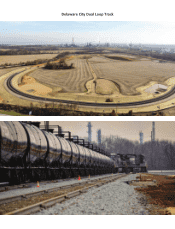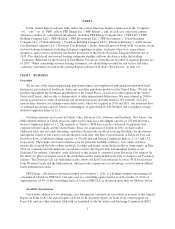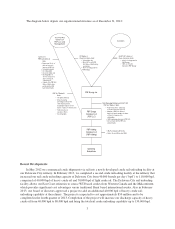PBF Energy 2012 Annual Report Download - page 16
Download and view the complete annual report
Please find page 16 of the 2012 PBF Energy annual report below. You can navigate through the pages in the report by either clicking on the pages listed below, or by using the keyword search tool below to find specific information within the annual report.
The following table approximates the Paulsboro refinery’s major process unit capacities. Unit capacities are
shown in barrels per stream day.
Refinery Units
Nameplate
Capacity
Crude Distillation Units ............................. 168,000
Vacuum Distillation Units ........................... 83,000
Fluid Catalytic Cracking Unit (FCC) ................... 55,000
Hydrotreating Units ................................ 141,000
Catalytic Reforming Unit (CCR) ...................... 32,000
Alkylation Unit (Alky) .............................. 11,000
Lube Oil Processing Unit ............................ 12,000
Delayed Coking Unit (Coker) ........................ 27,000
Propane Deasphalting Unit ........................... 11,000
Feedstocks and Supply Arrangements. In December 2010, we entered into a crude and feedstock supply
agreement with Statoil that will terminate effective March 31, 2013. Pursuant to the agreement, we direct Statoil
to purchase crude and other feedstocks for Paulsboro and Statoil purchases these products on the spot market.
Accordingly, Statoil enters into, on our behalf, hedging arrangements to protect against changes in prices
between the time of purchase and the time of processing the feedstocks. In addition to procurement, Statoil
generally arranges transportation and insurance for the crude and feedstock supply and we pay Statoil a per barrel
fee for their procurement and logistics services. Statoil holds title to the crude and feedstocks until we run the
crude or feedstocks through our process units. We pay Statoil on a daily basis for the corresponding volume of
crude or feedstocks that are consumed in conjunction with the refining process.
In addition, separate from our agreement with Statoil we have a long-term contract with Saudi Aramco. We
have been purchasing up to approximately 100,000 bpd of crude oil from Saudi Aramco that is processed at
Paulsboro pursuant to this agreement and on a spot basis. The crude purchased is priced off ASCI.
Product Offtake. We sell the bulk of Paulsboro’s clean products to MSCG through our offtake agreement,
which we have elected to terminate effective June 30, 2013. With the exception of certain jet fuel and lubricant
sales, MSCG purchases 100% of our finished clean products and intermediates under the offtake agreement.
Subsequent to termination of the offtake agreement, we intend to market and independently sell the products
currently purchased by MSCG including under certain existing agreements with other customers that we will
assume upon the MSCG termination. In addition to the finished products offtake agreement with MSCG, we sell
the remaining products produced at Paulsboro to third parties under various long-term contracts and on the spot
market.
Tankage Capacity. The Paulsboro refinery has total storage capacity of approximately 7.5 million barrels.
Of the total, approximately 2.1 million barrels are dedicated to crude oil storage with the remaining 5.4 million
barrels allocated to finished products, intermediates and other products.
Energy and Other Utilities. Under normal operating conditions, the Paulsboro refinery consumes
approximately 30,000 MMBTU per day of natural gas. The Paulsboro refinery is virtually self-sufficient for its
electrical power requirements. The refinery supplies approximately 90% of its 63 MW load through a
combination of four generators with a nameplate capacity of 78 MW, in addition to a 30 MW gas turbine
generator and two 15 MW steam turbine generators located at the Paulsboro utility plant. In the event that
Paulsboro requires additional electricity to operate the refinery, supplemental power is available through a local
utility. Paulsboro is connected to the grid via three separate 69 KV aerial feeders and has the ability to run
entirely on imported power. Steam is primarily produced by three boilers, each with continuous rated capacity of
300,000-lb/hr at 900-psi. In addition, Paulsboro has a heat recovery steam generator and a number of waste heat
boilers throughout the refinery that supplement the steam generation capacity. Paulsboro’s current hydrogen
needs are met by the hydrogen supply from the reformer. In addition, the refinery employs a standalone steam
methane reformer that is capable of producing 10 MMSCFD of 99% pure hydrogen. This ancillary hydrogen
plant is utilized as a back-up source of hydrogen for the refinery’s process units.
8
























